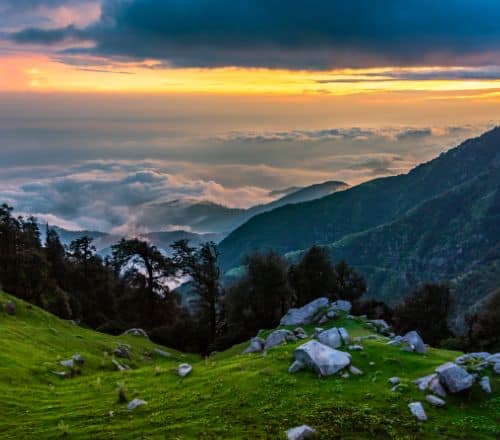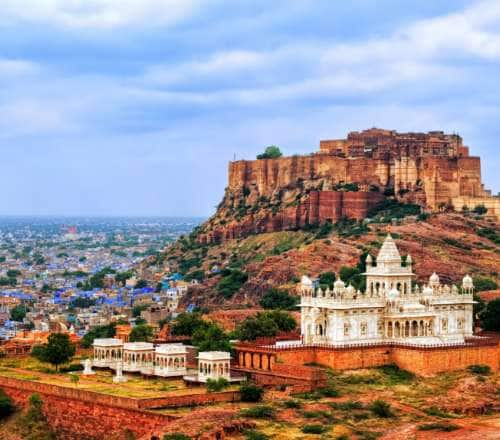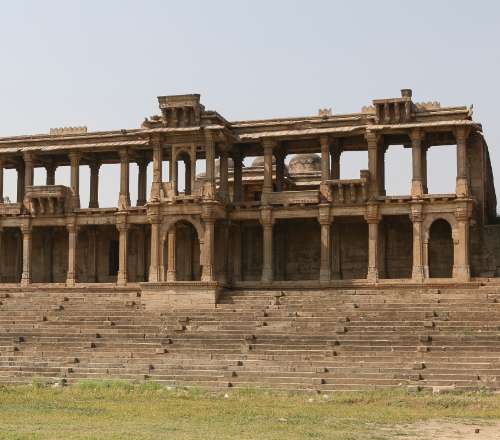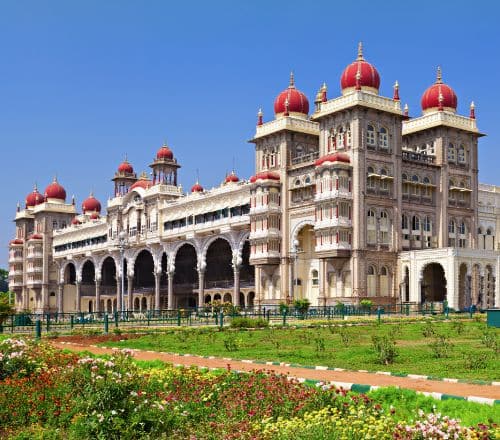Stay logged in to proceed with bookings, orders and offers.
On changing the terminal, you will loose items in your cart. Are you sure you want to change your terminal?
An eyewitness guide to unearthing architectural gems across the state of Gujarat.
Being a Gujarati means you’re either clubbed into one of two stereotypes promoted by the media: the shrewd businessperson or the die-hard foodie. Admittedly, I fall into the latter category, but I also like to throw light on one other aspect dear to every Gujarati, and that is a love for all things beautiful. Just look at the patola or bandhani saris worn traditionally by Gujarati women. A complex warp and weft technique is employed to bring the striking patola sari to life, while bandhani involves a laborious method of pinching small sections of the sari and tying them before dyeing the fabric with vibrant colours. All those hours of backbreaking labour are spent just to create something magnificent. Gujarat’s ties to fine craftsmanship spill beyond textiles to sculpture, art and, most notably, architecture. And that’s what I’m going to explore.
I begin my quest in Ahmedabad, one of Gujarat’s major cities. But I will forgo visiting the modern-day, bustling Ahmedabad, with its skyscrapers and swanky malls. Instead, I head to the Old City's pols, which have also earned the city its status as a World Heritage City. I spend a better part of the morning roaming the famed pols, or housing clusters, taking in the embellished wooden facades of houses tightly packed in the maze of streets.
Children, cows and elderly folk amble past me as the sun lights up the jaali windows. Some houses look like they have seen a lot of wear and tear but their beauty still shines through.
Most polls are characterised by a central courtyard where a chabutro (bird feeding tower) stands tall. It is believed that this labyrinthine network of lanes in the polls was designed strategically from a security point of view. Today, it is home to a community that’s just as close-knit thanks to the walls, courtyards, and common spaces designed to be shared by everyone living here. Privacy and space hold little meaning and it’s common to see women and children float in and out of neighbours’ houses as if they were their own. Each house has an oatla (verandah) where men shoot the breeze with friends and neighbours while women go about their day, keeping a watchful eye over their children. It’s a housing system unlike any other I have seen.
Pro tip: Sign up for a heritage walk to make the most of your visit (www.houseofmg.com/pages/heritage-walks).
Sultan Ahmed Shah created Ahmedabad in 1411 CE, which explains why the cityscape boasts many impressive mosques. The most famous of these is Jama Masjid, which is also my next stop. As I step through the mosque’s grand archway, I'm greeted with an enormous courtyard that calms me at once.
I take in the pillars placed in perfect symmetry before my eyes travel to the beautiful domes, some of which are shaped like lotuses. My guide informs me that this is because the mosque is built in an Indo-Islamic style. I run my hand along the ancient yellow sandstone columns and admire the graceful Arabic calligraphy interspersed with pretty motifs. I'm told that the prayer hall has an impressive 260 columns to support the 15 principal domes. This mosque is truly a marvel of architecture.
To witness more fine craftsmanship, I make my way to the Sidi Saiyed Mosque, a short distance from Jama Masjid. When I arrive at the 16th-century mosque, I'm not very impressed. The simple structure has a row of arches, flanked by two minarets and doesn't hold my attention. However, as I get closer, I see something interesting on the far end of the mosque.
The guide leads me to the road along the back of the mosque, and there I see it. The intricate latticework within the arches depicts the ‘Tree of Life’ and its numerous interweaving branches. The craftsmanship is so fine that it resembles delicate lace. I cannot comprehend how such intricate carving is achieved on stone. I'm not the only one mind-blown by this stunning piece of art. The Indian Institute of Management- Ahmedabad (IIM-A) has adopted this very motif as its official symbol.
I learn later that my breath will be taken away on many more occasions as I traipse through this incredible land. About 100 km from Ahmedabad lies the 11th-century Modhera Sun Temple. As the name suggests, it is dedicated to the Sun God, Lord Surya. As I enter the temple complex, the jaw-droppingly beautiful Ramakund comes into view. A fantastic example of beauty in symmetry, this rectangular stepwell holds 108 shrines dedicated to various Hindu gods.
Steps lead to the well from all four sides, and small pyramid-shaped steps, arranged at regular intervals, bring you closer to the water. I am mesmerised by this geometrical design as my eyes roam every inch of the stepwell before my guide leads me away to the main temple. The entrance hall has me in a trance once again. There are so many details to take in; the carvings on the pillars, leading up to the carvings on the ceiling of the domes, bringing my focus back down to the arches that resemble exquisite necklaces strung between two pillars. The temple is built in such a way that on every equinox, the first ray of the sun would fall in perfect alignment on the diamond adorning the head of the Sun God. Now that no deity remains in the temple, I have to use my imagination to appreciate what a spectacle it must be.
Another temple that took my breath away (quite literally) is the Palitana Jain Temple, near Bhavnagar. I climb approximately 3,500 steps to reach the complex of around 800 temples. We start early in the morning to beat the heat and by the time we reach the summit, my muscles are cramping. But that is all forgotten when my eyes land on the sea of brilliant white, marble-carved temples.
One of the holiest sites in Jainism, the main Adinath Temple is dedicated to Rishabha, the first Tirthankara (spiritual teacher and saviour). The monument is covered in geometric carvings outside, while within, elaborate designs adorn the pillars, walls and ceilings. Everything about the Palitana Temples, from its rich architecture and serene location to the difficult ascent alongside thousands of devotees and nimble-footed Jain munis (saints), makes for a lovely spiritual experience.
I move on from that humbling experience to an overwhelming regal one. My next stop is in a city, considered the state’s cultural capital: Vadodara. I'm here to explore the resplendent Laxmi Vilas Palace, which sits on 500 acres of land. The sheer grandeur of the palace has bowled me over even before I step inside. The palace is believed to be four times the size of Buckingham Palace, and standing before it I feel dwarfed.
A delightful ode to Indo-Sarcenic architecture, the façade is made up of hundreds of windows topped with Bengal roofs, chhatris, a tall tower, and a central cupola. This palace continues to serve as the residence of the royal family of Vadodara. When I step inside, I find that more finery and craftsmanship are on display. Venetian mosaic flooring, glamorous chandeliers, Belgian stained-glass windows, and artworks by the famous artist Raja Ravi Verma adorn the interiors. Another intriguing feature inside the palace is Navlakhi Vav, a step well built to cope with the water problems of Gujarat’s parched terrain.
But the most majestic stepwell in Gujarat has to be Rani ki Vav in the city of Patan. Translating to Queen’s Stepwell, the vav was built in 1063 by Rani Udayamati to commemorate her king, Bhimdev. Not only is this stepwell an engineering marvel, but it's decorations and sculptures make it a work of art. Did you know that Rani ki Vav enjoys a place on the INR 100 note? The photograph unfortunately doesn't do this glorious structure justice.
Numerous columns, steps, and pavilions make up this stepwell and every visible surface is bedecked with ornate sculptures, motifs, and latticework. Little wonder that its construction took two decades! It is believed that the stepwell was almost completely buried under silt and was thankfully rediscovered in the 1940s and restored by the Archaeological Survey of India (ASI) in the 1980s.
Gujarat’s rich history has resulted in a beautiful amalgamation of architectural styles that portray Mughal, Solanki, and even colonial flairs. Thanks to UNESCO, these architectural wonders are restored to their former glory. Now it is up to us to safeguard these treasures of the past.





The Adani One expressly disclaims all liability, direct and indirect, in respect to actions taken or not taken based on any or all the contents of this Blog. The Blog is an opinion of the contributor based on the collation of data from various sources and is provided only for information purpose. Adani One does not canvass, advertise, solicit, invite or induct for any product, merchandise, information, brand or any other materials mentioned in the Blog, nor does it obtain any monetary benefit from the same. Reader is advised to read and apply his/her intellect and discretion in this regard. Any Intellectual Property mentioned in this blog belongs to the rightful owner. We do not intent to claim any interest over the same.